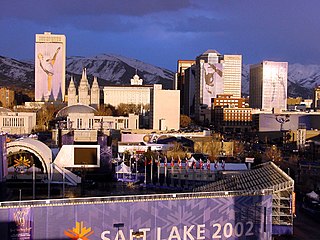
Snowbasin Resort is a ski resort in the western United States, located in Weber County, Utah, 33 miles (53 km) northeast of Salt Lake City, on the back (east) side of the Wasatch Range.

Alpine skiing has been contested at every Winter Olympics since 1936, when a combined event was held in Garmisch-Partenkirchen, Germany.

Theodore Sharp Ligety is a retired American alpine ski racer, a two-time Olympic gold medalist, and an entrepreneur, having cofounded Shred Optics. Ligety won the combined event at the 2006 Olympics in Turin and the giant slalom race at the 2014 Olympics in Sochi. He is also a five-time World Cup champion in giant slalom. Ligety won the gold medal in the giant slalom at the 2011 World Championships. He successfully defended his world title in giant slalom in 2013 in Schladming, Austria, where he also won an unexpected gold medal in the super-G and a third gold medal in the super combined.

Paralympic alpine skiing is an adaptation of alpine skiing for athletes with a disability. The sport evolved from the efforts of disabled veterans in Germany and Austria during and after the Second World War. The sport is governed by the International Paralympic Committee Sports Committee. The primary equipment used includes outrigger skis, sit-skis, and mono-skis. Para-alpine skiing disciplines include the Downhill, Super-G, Giant Slalom, Slalom, Super Combined and Snowboard.

South Africa sent a delegation to compete at the 2002 Winter Olympics in Salt Lake City, United States from 8–24 February 2002. This was South Africa's fourth time appearing at a Winter Olympic Games. The nation's delegation consisted of a single alpine skier, Alexander Heath. In his best performance, he finished 27th in the men's slalom.

Fiji sent a delegation to compete at the 2002 Winter Olympics, in Salt Lake City, Utah, United States from February 8–24, 2002. This was the nation's third appearance at a Winter Olympic Games. The delegation consisted of a single athlete, alpine skier Laurence Thoms. He competed in both the slalom, where he failed to complete his first run, and in the giant slalom, in which he finished 55th out of the 57 skiers who successfully completed both of their runs. Thoms gained media attention for representing a tropical nation at the Winter Olympics.

Bosnia and Herzegovina sent a delegation to compete at the 2002 Winter Olympics in Salt Lake City, United States from 8–24 February 2002. This was the nation's third time participating in a Winter Olympic Games. The delegation consisted of two alpine skiers, Tahir Bisić and Enis Bećirbegović. Bisić finished in 29th place in the men's slalom, and 44th in the giant slalom. Bećirbegović failed to finish the giant slalom, his only event.
Alpine skiing at the 2002 Winter Paralympics consisted of 53 events, 34 for men and 19 for women which all took place at the Snowbasin Ski Area.
The combined event was held on February 13 at Snowbasin. It consisted of 3 runs, a downhill and two runs in the slalom. American Bode Miller skied from 15th place after the downhill to a silver medal, 0.28 second behind Kjetil André Aamodt, who won a record sixth Olympic medal in alpine skiing.

The 2002 Winter Olympic Games were held in and around Salt Lake City, United States from February 8 to 24, 2002, and the Paralympics from March 7 to 16, 2002. The sporting events were held in ten competitive venues, while non-competitive events, such as the opening ceremony, were held in six other venues. Three venues were also created for training purposes. All Olympic venues were scattered throughout Northern Utah.

Australia competed at the 2002 Winter Paralympics in Salt Lake City, Utah, United States from 8 March to 19 March 2002. The Salt Lake Paralympics are the eighth such winter games, the first Winter Paralympics ever in North America and the first Winter Paralympics ever set up by an Olympic organizing committee. Although many of the Paralympic expenses were covered by dual planning with the Olympics, organizers still spent about $60 million on the Paralympics, including $5 million on the opening and closing ceremonies. The Salt Lake Games featured 92 events across four sports: alpine skiing, biathlon, cross-country, and ice sledge hockey. The 36 competing countries sent a total of 416 participants. Australia was represented by six male alpine skiers: Peter Boonaerts, Bart Bunting, Michael Milton, Scott Adams, Cameron Rahles-Rahbula, and Mark Drinnan. The medal haul was seven, consisting of six gold and one silver. Australia finished 8th overall in the gold and total medal count, making it the country's most successful Winter Games in terms of gold medals.
LW12 is a para-Alpine and para-Nordic sit skiing sport class defined by the International Paralympic Committee (IPC). An LW12 skier needs to meet a minimum of one of several conditions including a single below knee but above ankle amputation, monoplegia that exhibits similar to below knee amputation, legs of different length where there is at least a 7 centimetres difference, combined muscle strength in the lower extremities less than 71. For international competitions, classification is done through IPC Alpine Skiing or IPC Nordic Skiing. For sub-international competitions, classification is done by a national federation such as Alpine Canada. For para-Alpine, this class is subdivided into two subclasses.: LW12.1 and LW12.2. A new sit-skier competitor with only national classification will compete as LW12.2 in international competitions until they have been internationally classified.

LW11 is a para-Alpine and para-Nordic sit skiing sport class, a classification defined by the International Paralympic Committee (IPC for people with paralysis in the lower extremities and people with cerebral palsy that affects the lower half of the body. Outside of skiing, the competitor in this class is unable to walk. For international competitions, classification is done through IPC Alpine Skiing or IPC Nordic Skiing. For sub-international competitions, classification is done by a national federation such as Alpine Canada.

LW10 is a para-Alpine and para-Nordic sit-skiing classification for skiers who cannot sit up without support. For international skiing competitions, classification is conducted by International Paralympic Committee (IPC) Alpine Skiing and IPC Nordic Skiing, while national federations such as Alpine Canada handle classification for domestic competitions.

LW2 is a para-Alpine and para-Nordic standing ski sport class defined by the International Paralympic Committee (IPC). Competitors in this class have severe disability in a lower limb, which may be a result of an amputation, or arthrodesis in the leg and hip. Depending on the type of skiing, the international classification process for LW2 skiers is handled by the IPC Alpine Skiing Technical Committee and IPC Nordic Skiing Technical Committee. National sport federations handle classification on the lower levels.
LW5/7 is a standing para-Alpine and para-Nordic skiing classification for skiers with upper extremity issues in both limbs that may include double amputation of both arms and hands or dysmelia of the upper limbs. The class has three subclasses defined by the location of the disability on the upper extremities. International classification is done by IPC Alpine Skiing and IPC Nordic Skiing. On the national level, classification is handled by national sports federation such as Cross-Country Canada.

LW6/8 is a para-Alpine and para-Nordic standing skiing sport class, a classification defined by the International Paralympic Committee (IPC) for people with an upper extremity issue who have paralysis, motor paresis affecting one arm, a single upper arm amputation or CP8 classified cerebral palsy. LW6/8 skiers use two skis and one pole in both para-Alpine and para-Nordic skiing.

The 1957 NCAA Skiing Championships were contested at Snow Basin at Mount Ogden, Utah, at the fourth annual NCAA-sanctioned ski tournament to determine the individual and team national champions of men's collegiate alpine skiing, cross-country skiing, and ski jumping in the United States.
Hilmi Esat Bayındırlı, also known as Erik Bayindirli, is a Turkish-American Paralympic alpine skier, who competes in the LW11 disability class of mostly men's giant slalom, sitting event. He represented United States at the 2006 Winter Paralympics and Turkey at the 2014 Winter Paralympics. A trained jeweller, he was paralyzed below the chest following a car accident in his youth.
Rolf Heinzmann is a Swiss para-alpine skier. He represented Switzerland at the Winter Paralympics in 1980, 1984, 1994, 1998 and 2002.


















